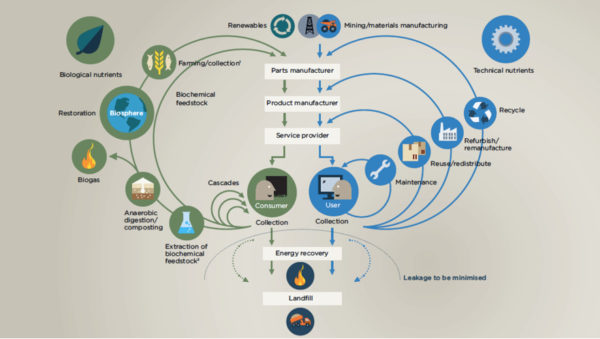Circular frameworks, especially the term circular economy, made great strides in 2018.
Circular frameworks allow us to move systems towards waste reduction and resource reutilization. The term circular economy now appears in many company sustainability commitments, and has provided a framework for new business models and business opportunities. It also provides a visual and understandable way to communicate to stakeholders, including investors, suppliers and consumers.
Circular frameworks include such terms as the circular economy, cradle to cradle and to a lesser extent, Biomimicry. They are designed to address the challenge of “unsustainable growth,” and the textile industry is certainly a good example of that. Fast fashion, seasonal products, cheap labor, and a competitive landscape have resulted in inexpensive clothes that allow consumers to buy a lot, wear them a few times and then throw them away.
My last blog post identified the Ellen MacArthur Foundation as a leader in circular textiles. Her foundation provides tools and definitions for organizations to use to explain the circular economy. Before we get into an explanation of different circular frameworks, it is first important to understand how they are different from linear frameworks, which are the status quo.
Linear framework – Take – Make – Dispose
Raw materials are either grown or extracted from the earth. They are made into products and we use those products. After their use phase is over, (in the case of apparel, the product may not fit anymore, it may rip or tear, or it simply goes out of fashion), they are mostly thrown away and eventually end up in landfills. This results in a high degree of waste.
Circular frameworks – Regenerative and restorative by design
In a circular framework, the product does NOT go into the landfill. Instead it can go through a series of transformations that extend its life, value and use. Materials re-enter the economy as technical or biological nutrients. Apparel may be repaired, repurposed (old denim jeans are used to make building insulation) or reused. (Goodwill, jumble sales, second hand stores etc.)
Cradle to cradle – the first circular framework
Circular frameworks were popularized through the cradle to cradle concept developed by Michael Braungart and William McDonough. Cradle to Cradle is a registered trademark of McDonough Braungart Design Chemistry (MBDC) and can be used to guide the design of products, cities, buildings and economics.
Cradle to cradle is centered on the concept of “material cycling,” which avoids degradation or down-cycling and instead, promotes up-cycling. Materials, at the end of their useful life, become either biological or technical nutrients.
The purpose of cradle to cradle design is to substitute harmful or wasteful materials with either natural and decomposable ones, or materials that can be used endlessly in industrial cycles.
In cradle to cradle, components used to make materials are categorized as technical or biological nutrients.
- Technical nutrients are non-toxic, synthetic materials that have no negative impacts on the environment. Their integrity and quality is maintained and they are used in continuous cycles.
- Biological Nutrients are organic materials that can be disposed of safely. They will typically decompose into the soil without affecting the natural environment and potentially restore eco systems.
Cradle to cradle is based on a few key principles:
Waste is food. Generated materials become ‘food’ for biological or industrial systems.
The use of infinite renewable energy. Cradle to Cradle systems use energy from the sun or wind, because they do not deplete natural resources nor do they contribute to greenhouse gas emissions.
Healthy ecosystems by utilizing natural diversity and locally adaptable systems.
The circular economy – The Ellen MacArthur butterfly diagram
According to the Waste and Resources Action Programme (WRAP), a circular economy is an economy in which we keep resources in use for as long as possible, extract the maximum value from them whilst in use, then recover and regenerate products and materials at the end of each service life.
The circular economy tends to put a greater emphasis on technical materials that circulate within the closed-loop system of production, reuse, recovery, and remanufacture.
The butterfly diagram, developed by the Ellen MacArthur Foundation, showcases different circular business models that support the circular economy.
For the system to work effectively, technical and biological nutrients are kept in separate cycles.

Technical nutrients should be reused again and again and stay out of the landfill. This can occur through several different approaches.
Circular business models
- Collection. Products are collected instead of thrown away
- Maintenance. Products are maintained to prolong their life
- Reuse. Products are resold or shared
- Refurbish. Products are refurbished or repaired
- Recycle. Products are recycled at the end of their life
The apparel and footwear industry has embraced the butterfly diagram. Later blog posts will provide examples of each circular business model shown in the diagram.
Impacts to your business?
Questions to consider:
- Do you incorporate circular frameworks into business strategies?
- Do your consumers embrace circularity?
For help with sustainability, circularity and chemicals, contact Amanda Cattermole at (415) 412 8406 or Amanda@cattermoleconsulting.com. We can help you develop powerful solutions to protect your company and brand reputation.
Tips and Insights contains information to help you make informed sustainability decisions. Each post highlights a particular topic and includes questions you may want to consider for your business.

